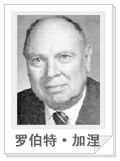罗伯特·加涅(Robert M. Gagnè)
——心理学家、教育家、世界著名教育技术学专家(1916—2002 )
——心理学家、教育家、世界著名教育技术学专家(1916—2002 )

1958年离开部队后,1959年在普林斯顿大学任心理学教授,1962年至1965年出任美国科研工作协会研究主任,1966年在加利福尼亚大学贝克菜分校任教,1969年以后一直在佛罗里达州立大学任教。
加涅在教育心理学方面作出了很大贡献。他所关注的重点,是把学习理论研究的结果运用于教学设计。他曾当选为美国心理会教育心理学分会主席、美国教育研究会主席。曾获美国心理学会颁发的桑代克教育心理学奖和杰出科学贡献奖。
加涅的主要代表著作《学习的条件(The Conditions of Learning)》使他饮誉全球。该书自1965年首版以来,于1970年、1977年和1985年分别出了修订版,每版的体系与内容都作了相当大的调整和充实,被认为是“关于学与教的最重要的著作之一”。此外,他的《教学设计的原理(Principles of Instructional Design)》(1974,1979,1988,与人合作)和《教学的学习要素(Essentials of Learning for Instruction)》(1974)注重教学实践的改革,日益受到心理学界和教育界人士的重视。
罗伯特·加涅(R. M. Gagné)是美国当代著名心理学家,后半生将主要精力集中于学习理论、教学设计乃至教育技术学基础理论的研究和构建中,并成为心理学和教育技术学这两个研究领域公认的大师级人物。他为教育技术学的形成与发展做出了杰出的贡献,留下了不可磨灭的足迹;加涅学术生涯长达60余年,几乎与美国教育技术学发展史同步,对加涅的研究可以从一个独特的视角研究和思考美国教育技术学发展的轨迹。正是基于此,美国教育技术学界自20世纪80年代后期掀起了研究加涅思想的热潮。1987年犹他州立大学教学技术系举办了“关于教学设计的对话”的研讨会,会上加涅和另一位教育技术著名学者梅瑞尔(M. David Merrill)围绕教学设计领域的一系列重大课题,就各自提出的理论进行了广泛而深入的对话,1990年戴维(Twitchell, David)根据当时的录像整理成7篇文章,在美国教育技术学的权威刊物Educational Technology上连续发表。这次两位大师级人物的对话,不仅大大提高了教学设计理论研究的水平,同时也促进了美国教育技术学界对大师级人物学术思想的研究。1989年佛罗里达州立大学为纪念加涅的学术成就,出版了《学习研究50年》(Studies of learning: 50 years of research.,R. M. Gagné,1989,Tallahassee, FL: Learning Systems Institute, Florida State University),该书收录了加涅发表的几乎全部论文(1989年以前),每篇文章均作了介绍性的评述。这本加涅文集的出版标志着美国教育技术学界开启了对加涅思想的梳理工作。为了纪念加涅对美国教育技术学发展的重大贡献,2000年由丽塔·里奇(Rita C. Richey)主持,汇集当代美国教育技术学领域的著名专家学者,出版了《罗伯特·加涅的思想财富》(The Legacy of Robert M. Gagné)一书,将加涅思想研究推向了一个新的高度。里奇在该书序言中对加涅作了如下评价:“这本书献给加涅,感激他对教育技术学领域的所做出的重大贡献”,“如果没有加涅的工作,教育技术学领域今天将会完全不同”。加涅于2002年4月28日去世,享年85岁,2003年3月29日,为怀念加涅,佛罗里达州立大学举办了“纪念加涅研讨会”, Robert Glaser、Dr. James 、K. (Ken) Brewer、 Dr. Robert Branson、Dr. Roger Kaufman、 Dr. Robert. Morgan 等当代著名教育心理学家、教育技术学专家及加涅的生前好友、学生等出席了这次会议。
我国心理学界20世纪80年代开始组织翻译加涅有关著作,并开展了对加涅理论的研究工作,但大多是从教育心理学的角度予以分析与探讨;教育技术学界90年代初翻译了加涅主编的《教育技术学基础》,部分教材对加涅理论也有所介绍,但目前系统梳理加涅思想形成与发展的脉络及其理论体系内在逻辑结构,从教育技术学视野中考察加涅思想在美国教育技术学发展中的重要地位及其理论价值、现实与的未来指导意义,尤其是对中国教育技术学发展的影响,至今尚未得到充分的重视。这显然是我国教育技术学基础理论建设中所不可缺少的基础性研究工作。
加涅在教育心理学方面作出了很大贡献。他所关注的重点,是把学习理论研究的结果运用于教学设计。他曾当选为美国心理会教育心理学分会主席、美国教育研究会主席。曾获美国心理学会颁发的桑代克教育心理学奖和杰出科学贡献奖。
加涅的主要代表著作《学习的条件(The Conditions of Learning)》使他饮誉全球。该书自1965年首版以来,于1970年、1977年和1985年分别出了修订版,每版的体系与内容都作了相当大的调整和充实,被认为是“关于学与教的最重要的著作之一”。此外,他的《教学设计的原理(Principles of Instructional Design)》(1974,1979,1988,与人合作)和《教学的学习要素(Essentials of Learning for Instruction)》(1974)注重教学实践的改革,日益受到心理学界和教育界人士的重视。
罗伯特·加涅(R. M. Gagné)是美国当代著名心理学家,后半生将主要精力集中于学习理论、教学设计乃至教育技术学基础理论的研究和构建中,并成为心理学和教育技术学这两个研究领域公认的大师级人物。他为教育技术学的形成与发展做出了杰出的贡献,留下了不可磨灭的足迹;加涅学术生涯长达60余年,几乎与美国教育技术学发展史同步,对加涅的研究可以从一个独特的视角研究和思考美国教育技术学发展的轨迹。正是基于此,美国教育技术学界自20世纪80年代后期掀起了研究加涅思想的热潮。1987年犹他州立大学教学技术系举办了“关于教学设计的对话”的研讨会,会上加涅和另一位教育技术著名学者梅瑞尔(M. David Merrill)围绕教学设计领域的一系列重大课题,就各自提出的理论进行了广泛而深入的对话,1990年戴维(Twitchell, David)根据当时的录像整理成7篇文章,在美国教育技术学的权威刊物Educational Technology上连续发表。这次两位大师级人物的对话,不仅大大提高了教学设计理论研究的水平,同时也促进了美国教育技术学界对大师级人物学术思想的研究。1989年佛罗里达州立大学为纪念加涅的学术成就,出版了《学习研究50年》(Studies of learning: 50 years of research.,R. M. Gagné,1989,Tallahassee, FL: Learning Systems Institute, Florida State University),该书收录了加涅发表的几乎全部论文(1989年以前),每篇文章均作了介绍性的评述。这本加涅文集的出版标志着美国教育技术学界开启了对加涅思想的梳理工作。为了纪念加涅对美国教育技术学发展的重大贡献,2000年由丽塔·里奇(Rita C. Richey)主持,汇集当代美国教育技术学领域的著名专家学者,出版了《罗伯特·加涅的思想财富》(The Legacy of Robert M. Gagné)一书,将加涅思想研究推向了一个新的高度。里奇在该书序言中对加涅作了如下评价:“这本书献给加涅,感激他对教育技术学领域的所做出的重大贡献”,“如果没有加涅的工作,教育技术学领域今天将会完全不同”。加涅于2002年4月28日去世,享年85岁,2003年3月29日,为怀念加涅,佛罗里达州立大学举办了“纪念加涅研讨会”, Robert Glaser、Dr. James 、K. (Ken) Brewer、 Dr. Robert Branson、Dr. Roger Kaufman、 Dr. Robert. Morgan 等当代著名教育心理学家、教育技术学专家及加涅的生前好友、学生等出席了这次会议。
我国心理学界20世纪80年代开始组织翻译加涅有关著作,并开展了对加涅理论的研究工作,但大多是从教育心理学的角度予以分析与探讨;教育技术学界90年代初翻译了加涅主编的《教育技术学基础》,部分教材对加涅理论也有所介绍,但目前系统梳理加涅思想形成与发展的脉络及其理论体系内在逻辑结构,从教育技术学视野中考察加涅思想在美国教育技术学发展中的重要地位及其理论价值、现实与的未来指导意义,尤其是对中国教育技术学发展的影响,至今尚未得到充分的重视。这显然是我国教育技术学基础理论建设中所不可缺少的基础性研究工作。
Robert M.Gagnè(1916—2002)